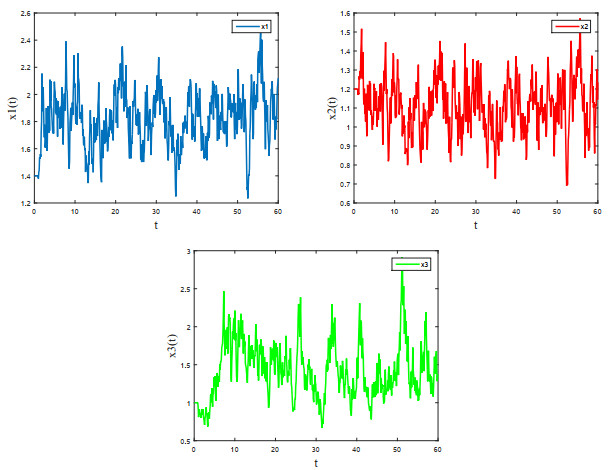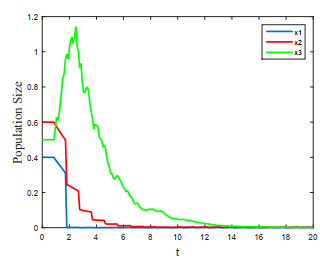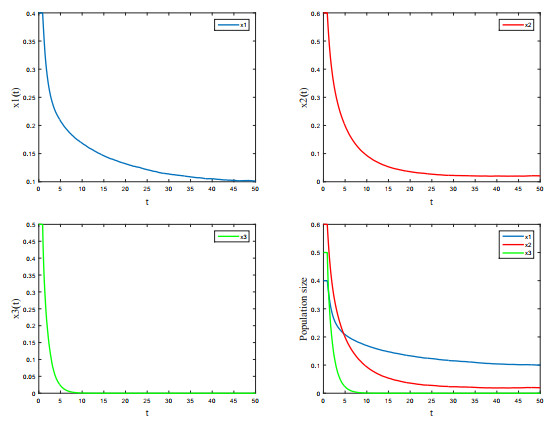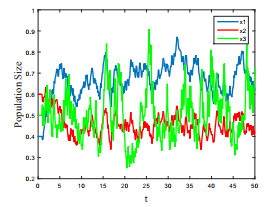1.
Introduction
The stochastic model of a predator and prey has been widely investigated for many years[1,2,3,4]. It is well known that two species models are difficult to describe ecological changes, and the critical behaviors can only be expressed by population models of more species. Because of its theoretical and practical significance, it is also one of the most important problems in theoretical ecology to study the dynamic characteristics of the one predator and two competitive prey population model, such as permanent existence, extinction, stability and periodicity [5,6,7,8,9]. Ma et al. [5] proposed the one predator and two competitive preys model for the first time. Ahmad considered a competitive trio of species satisfying two inequalities involving the growth rate and the average interaction coefficient, which implies persistence [7]. By constructing auxiliary equations and Lipschitz conditions, Qiu [9] proved that the three-dimensional Lotka-Volterra system has a stationary distribution. Freedman's analysis of equilibrium points for three-level models, stability criteria, and minimum carrying capacity for population persistence and extends the work on the Lotka-Volterra model. It is shown that the recent research models are closer to reality and increase in dimensionality [8].
In addition, time delays can not be ignored in biological model. Time delay is a common problem in many practical systems, which will lead to system instability or oscillation. Therefore, the stability of time-delay systems has been one of the hot topics in recent twenty years [10,11,12,13,14,15,16,17,18,19]. Xu [12] used some differential inequalities and random analysis techniques to study a class of switched systems with delays. Nevertheless, the impulse is a discrete moment in a very short time interval to a supercritical state [20,21,22]. Pulse perturbation has been extensively studied in the fields of ecology and epidemiology. The population dynamic system is studied extensively by impulse differential equation [11,12,19,23,24,25,26,27]. Lu [25] obtained the threshold between weak persistence and extinction by using Itô's formula theorem and mathematical analysis.
Bio-mathematic stability refers to the ability of a biological system to maintain its stable state when various factors or parameters change. Biological systems are usually affected by internal and external environments, including changes in temperature, nutrition, water, oxygen, light and other factors, as well as interactions between organisms. Exponential stability means that the index remains relatively stable within a certain period of time. Hutson [6] pointed out that asymptotic stability and global asymptotic stability are intuitive concepts that neither of the two most widely used conditions can reflect persistence in a satisfactory way. Practical exponential stability of differential equations is a kind of asymptotic stability with good properties and a kind of Lyapunov stability. That is, the system state is kept stable by allowing the system to oscillate in a small neighborhood [28,29,30,31,32]. Yao investigated the practical exponential stability of mild solutions with delays using direct and indirect methods [29]. As far as we know, there are few studies on stochastic impulsive high-dimensional models with time-varying delays. The study of the delay independent and Markovian effects of the practical exponential stability of the following impulsive stochastic model with time varying delay for one predator and two competitive preys model has not been done:
where xi(θ)=ϕi(θ),−τ0≤θ≤0,t≥0. xi(t), i=1,2,3 stands for population size of the two independent prey and one predator population at t, respectively. aij>0(i,j=1,2,3). τmin≤τi(t)≤τmax represent the time-varying delay, where τmin and τmax are given bounds. ϕ(θ)=(ϕ1(θ),ϕ2(θ),ϕ3(θ))⊤∈U, U=C([−τ0,0],R3+) represent the space of all the continue function. The Brownian motions Bi(t)(i=1,2,3) defined on a complete probability space (Ω,Ft,(Ft)t≥0,P) with a filtration (Ft)t≥0 are independent to each other. 0<t1<t2<⋯<tk<⋯ and limk→+∞tk=+∞. In view of biological significance in reality, we just consider 1+αik>0(i=1,2,3), which is a natural constraint. Pulse parameter αik refer to specific properties of the pulse, such as pulse width, frequency, peak voltage and repetition rate. In biological research, pulse parameters can affect the response and reaction mode of organisms. The biological interpretations of these parameters are described in Table 1.
This paper studies the well-posedness and asymptotic behavior of the model (1.1). The main contributions of this paper lie in that this paper reveals the following facts: (ⅰ) The practical exponential stability under the condition of bounded pulse intensity is not affected by the impulsive perturbation. (ⅱ) Razumikhin inequality can be used to transform the solution of the stability of non-Markovian processes to the solution of the stability of Markovian ones. (ⅲ) In some cases, a non-Markovian process can produce Markovian effects. Moreover, examples obtained the theoretical results for the existence of practical exponential stability through the relationship between parameters, pulse intensity and noise intensity. The work in literature [11] is generalized.
2.
Prilimary
For convenience, we use the following notations. If f(t) is a continuous bounded function on R+, define fu=supt∈R+f(t), fl=inft∈R+f(t). ¯f(t)=t−1∫t0f(s)ds, f∗=lim supt→+∞f(t), f∗=liminft→+∞f(t). Define the norm |y|=∑ni=1.
Next, we consider the stochastic equations
where ϕ∈C([−τ0,0],Rn), x∈Rn, xt∈LpFt([−τ0,0],Rn), f:LpFt(R+×([−τ0,0],Rn))→Rn, g:LpFt(R+×([−τ0,0],Rn))→Rn×m.
The Lyapunov operator is defined as:
Definition 1. Let x(t)=(x1(t),x2(t),x3(t))⊤ be the solution of model (1.1).
1) p is a positive integer, and if limt→+∞E|x(t)|p>0, then the species is pth moment persistent, and limt→+∞E|x(t)|p=0, the species is pth moment extinct [30].
2) If limt→+∞xi(t)=0, and species xi(t) is extinction, limt→+∞¯xi(t)=0, then species xi(t) is considered to be non-persistent in the mean.
3) If ¯xi∗>0, and species xi(t) is weakly persistent in the mean, x∗i>0, then species xi(t) is considered to be weakly persistent.
4) Moment stabilization, also known as pth moment stabilization, requires convergence to zero moments of order p.
5) For p>0, system (1.1) is said to be pth moment practical exponential stability[28]. If there exist positive constants Z1>0, Z2≥0 and ℓ>0, then
Lemma 1. ([4]) The solution x(t) of the predator-prey model (1.1) obeys
3.
Global positive solutions
Under the condition of bounded pulse intensity, an equivalent equation is established to obtain a pure differential equation of the same type as (2.4) in [34], and the existence of a global solution is obtained. Building an equivalence system:
where yi(θ)=ϕi(θ), −τ0≤θ≤0,t≥0, xi(t)=Ai(t)yi(t) and Ai(t)=(∏kj=1(1+αij))−t∏tk<t(1+αik).
Let y(t)=(y1(t),y2(t),y3(t))⊤,
dB(t)=(dB1(t),dB2(t),dB3(t))⊤, ϕ(θ)=(ϕ1(θ),ϕ2(θ),ϕ3(θ))⊤, then (3.1) can be rewritten as
For model (1.1), we always assume
(T1) In terms of biological significance, we consider 1+αij>0, j∈N, i=1,2,3.
(T2) ∃ C1>0, C2>0, C1≤∏kj=1(1+αij)≤C2, C1≤∑kj=1(1+αij)≤C2, i=1,2,3.
Theorem 1. Assume (T1) and (T2) hold, there exists a unique solution y(t) on t∈R+=[0,∞), and the solution remain in R3+ with probability 1 in (3.2).
Proof. Because ri+∑kj=1ln(1+αij)(i=1,2), −r3+∑kj=1ln(1+α3j) and Ai(t),i=1,2,3 are bounded, we can prove that the model (3.2) has a unique global solution y(t) remain in R3+ with probability 1 under the condition of (T1) and (T2) by the same method as lemma 2.2 in [34]. In fact, Eq (2.4) in [34] is pure differential equation, while the Eq (3.2) in this paper is a simultaneous differential equation of the same type. It's proof is similar, so we omit. □
Theorem 2. By the equivalence system and xi(t)=Ai(t)yi(t), xi(t) is a solution of the original system (1.1).
Proof. The proof of the theorem is along the same lines as in [15]. □
Remark 1. Theorem 2 shows that under conditions (T1) and (T2), the solutions to the original system and the auxiliary system has the same asymptotic behavior. In order to facilitate the study, we convert the four-dimensional equation into the three-dimensional equivalent equation, which provides convenience for the following studies on the extinction, non-persistence and practical exponential stability of the system.
4.
Persistence and extinction
Theorem 3. (Ⅰ) If h∗i<0(i=1,2), then the prey xi(i=1,2) will be extinct, where hi(t)=∑kj=1,0<tk<tln(1+αij)+ri−0.5σ2i+1tlnAi(t), (i=1,2).
(Ⅱ) If h∗i=0(i=1,2), then the prey xi(i=1,2) is non-persistent in the mean.
(Ⅲ) If h∗i>0(i=1,2), lim supt→+∞∑kj=1,0<tk<tln(1+αij)lnt<∞(i=1,2) and h∗3<0, then the prey xi(i=1,2) is weakly persistent in the mean, where }h3(t)=∑kj=1,0<tk<tln(1+α3j)−r3−0.5σ23+1tlnA3(t).
Proof. Applying Itô's formula to the model (3.1) yields
and
where x(0)=ϕ0, Λi(t)=∫t0σidBi(s)(i = 1, 2, 3), local martingale quadratic variation satisfies ⟨Λi,Λi⟩(t)=∫t0σ2idBi(s)≤σ2it (i = 1, 2, 3). Using strong law of large numbers [27], we obtain
Case (Ⅰ). Taking the limit in (4.1), (4.2) and using (4.4),
So, limt→+∞xi(t)=0(i = 1, 2) a.s. hold.
Case (Ⅱ). By (4.4), for ∀ε>0, ∃ T>0, thenlnxi(0)t<ε3, hi(t)<h∗i+ε3 and Λit<ε3(i=1,2). Add (4.1) and (4.2) to the equation above, we have
So,
Using Lemma 3.2 in [25], then
For ∀ε, we have limt→+∞¯xi(t)=0.
Case (Ⅲ). By Lemma 1 and the condition lim supt→+∞∑kj=1,0<tk<tln(1+αij)lnt<∞(i=1,2), we can easily get [t−1lnxi(t)]∗≤0(i=1,2) a.s. The following formula can be obtained by taking limit in (4.1) and (4.2)
Therefore, ¯xi∗>0 (i = 1, 2) a.s. For ∀ω∈{¯xi(t,ω)=0,i=1,2}, ¯x3(t−τ3(t),ω)∗>0. Yet, for (4.3) take the superior limit and use ¯xi∗=0(i=1,2) a.s. yields
In other words, limt→∞x3(t,ω)=0, which the contradiction arises. Therefore, ¯xi∗>0(i=1,2) a.s.
□
Corollary 1. (Ⅰ) If, in addition to (T2), the model (1.1) satisfies the condition ri<0.5σ2i, 1≤i≤2, the prey xi,1≤i≤2, will be extinct.
(Ⅱ) If, in addition to (T2), the model (1.1) satisfies the condition ri=0.5σ2i, 1≤i≤2, the prey xi,1≤i≤2, will be non-persistent in the mean.
(Ⅲ) If, in addition to (T2), the model (1.1) satisfies the condition ri>0.5σ2i, 1≤i≤2 and −r3<0.5σ23, the prey xi,1≤i≤2, will be weakly persistent in the mean.
Proof. The impulsive perturbations are bounded by (T2).
So,
From (T2), we have
Similarly,
Based on Theorem 3, we can get Corollary 1.
Theorem 4. (Ⅰ) If a11a22h∗3+a31a22h∗1+a32a11h∗2<0 and h∗3<0, then the predator x3 will be extinct.
(Ⅱ) If a11a22h∗3+a31a22h∗1+a32a11h∗2=0, h∗3<0 and lim supt→+∞∑kj=1,0<tk<tln(1+αij)lnt<∞(i=1,2,3), then the predator x3 is non-persistent in the mean.
(Ⅲ) If h∗3>0, a31a22h∗1+a11a32h∗2+a11a22h∗3>a32a11a21¯x1∗+a31a22a12¯x2∗
and lim supt→+∞∑kj=1,0<tk<tln(1+αij)lnt<∞(i=1,2,3), then predator x3 is weakly persistent in the mean.
Proof. Case (Ⅰ). If h∗i≤0(i=1,2) a.s., ¯xi∗=0(i=1,2) a.s. can be obtained by Theorem 3. Since superior limit h∗3<0, for ∀ε>0, ∃T>0 such that h3(t)<h∗3+ε, for all t>T. From (4.3), we get
In order to seek the type on the limit, we have
Thus, limt→+∞x3(t)=0,a.s. If h∗i>0(i=1,2), from (4.1), (4.2) and (4.4), we can obtain
Using Lemma 3.2 in [25], we have
From (4.3) and (4.7), we see
So, limt→+∞x3(t)=0,a.s. If h∗1>0,h∗2=0 or h∗1=0,h∗2>0, we can also obtain the same result. Here we omit the proof.
Case (Ⅱ). It has been proved from case (Ⅰ) that if h∗i≤0(i=1,2), we can get limt→∞x3(t)=0, a.s. That is, ¯x3(t)∗=0, a.s. Now suppose h∗i>0(i=1,2). If ¯x3(t)∗>0, a.s., [t−1lnx3(t)]∗=0. a.s. is obtained from Lemma 1 and from assumption lim supt→∞∑kj=1,0<tk<tln(1+α3k)lnt<∞. By (4.3), we have
On the flip hand, for ∀ε>0, ∃ T>0, then
From (4.3), we get
Using Lemma 3.2 in [25], we have
which indicates that
Substituting (4.7) into the above inequality yields
Then conflict arises. Thus, ¯x3∗=0 a.s.
Case (Ⅲ). Multiplying (4.1)–(4.3) by a31a22, a32a11 and a11a22, respectively, we find
Local martingale, the strong law was applied to get limt→∞∫t0a31a22σ1dB1t=0, limt→∞∫t0a32a11σ2dB2t=0, limt→∞∫t0a11a22σ3dB3t=0,a.s. To find the superior limit of (4.8) and noting that (t−1lnxi(t))∗≤0,1≤i≤3a.s., we have
That is
So ¯x3∗>0 a.s., i.e., the predator x3 is weakly persistent in the mean.
The proof is therefore completed. □
Corollary 2. (Ⅰ) If, in addition to (T2), the model (1.1) satisfies the condition a31a22(r1−0.5σ21)+a32a11(r2−0.5σ22)≤a11a12(r3+0.5σ23), the predator x3 will be extinct.
(Ⅱ) If, in addition to (T2), the model (1.1) satisfies the condition a31a22(r1−0.5σ21)+a32a11(r2−0.5σ22)=a11a12(r3+0.5σ23), the predator x3 is non-persistent in the mean.
Proof. From (T2), we know that ∑kj=1,0<tk<tln(1+αij)=ln∏kj=1,0<tk<t(1+αij), 1≤i≤3, is bounded variable. So, lim supt→∞∑kj=1,0<tk<tln(1+αij)lnt=lim supt→∞ln∏kj=1,0<tk<t(1+αij)lnt=0,1≤i≤3.
Based on h∗i=ri−0.5σ2i,(1≤i≤2),t>0, and h∗3=−r3−0.5σ23,t>0, we have the following conclusions.
1) If a31a22(r1−0.5σ21)+a32a11(r2−0.5σ22)<a11a22(r3+0.5σ23), then a31a22h∗3+a31a22h∗1+a32a11h∗2<0 and h∗3<0 hold. From Theorem 4, the predator x3 will be extinct.
2) If a31a22(r1−0.5σ21)+a32a11(r2−0.5σ22)=a11a22(r3+0.5σ23), then a31a22h∗3+a31a22h∗1+a32a11h∗2=0 and h∗3<0 hold. From Theorem 4, the predator x3 is non-persistent in the mean. □
Remark 2. When a13=a23=a31=a32=a33=0, r3=0, τij(t)=0, σ3=0, the model (1.1) degenerates into the model studied in Wu et al. [23]. Theorems 3 and 4 include some results of Wu et al. [23] as a special case.
Practical exponential stability is a kind of asymptotic stability with good properties and a kind of Lyapunov stability. According to Lemmas 2 and 3 in [15], we obtain the first moment practical exponential stability of the system. The system (2.1) is also considered to be pth moment exponential stability [30]. Indeed, ignoring the impulse in Theorem 3.1 in [30], the theorem reduces to Lemma 2 in [15]. Practical exponential stability means to some extent the permanence of the population. The system (2.1) is considered to be pth moment exponential stability[30].
Proof. The proof is similar to [30], here we omit it. □
Theorem 5. Let Ri=ri+∑kj=1ln(1+αij)(i=1,2), R3=−r3+∑kj=1ln(1+α3j), and 2a11a22a33A3−a22a231A1−a11a232A2≠0.
I=a11a22(R3−a33A3)24a11a22a33A3−2a22a231A1−2a11a232A2+ A1(2a11)−1(R1A1−a11−a21+a31)2+A2(2a22)−1(R2A2−a12−a22+a32)2+(R1+R2+R3)+σ21+σ22+σ232. Assume that Aij(t−τij(t))<Aij(t), (T1), (T2) and the Razumikhin conditions hold
where t≥0,i,j=1,2,3. If I>0, then model (3.1) is 1th moment practical exponential stability, that is model (1.1) is 1th moment persistence. On the contrary, when I<0, then model (3.1) is 1st moment exponential stability, that is model (1.1) is 1st moment extinction.
Proof. Let Vi(y)=yi+ln(yi+1), V(y)=V1+V2+V3.
Then
From (4.9) and (4.11), we get
The constructed V function, and inequality (4.18)–(4.20) satisfies the Lemma 2 in [15], then
Similarly, we have
So
If I>0, the system (1.1) is 1st moment practical exponential stability. I<0, the system (3.1) is 1st moment exponential stability. Practical exponential stability means to some extent the permanence of the population, exponential stability implies a degree of extinction. □
Corollary 3. (Ⅰ) In addition to (T2) and (4.18), if the model (1.1) meets the following conditions
then
(Ⅰ)
the system (1.1) is 1st moment persistence.
(Ⅱ)
the system (1.1) is 1st moment extinction.
Proof. If the condition (4.17)–(4.19) hold, from (4.16), we have
From Theorem 5, the Corollary 3 is true.
In fact, when αij=0,1≤i≤3, j=1,2,⋯, then Ai=1,1≤i≤3 and Ri=ri+∑kj=1ln(1+αij)=ri,1≤i≤3. From (4.17)–(4.19), we have ri=Ri=a1i+a2i−a3i,1≤i≤2, r3=R3=a33. The following conditions can be obtained by using Corollary {3}. □
Remark 3. Since the model (1.1) contains time delay, it is a non-Markov process. In solving the stability of non-Markovian processes, it is transformed into solving the stability of Markovian processes by applying Razumikhin's inequality. In some cases, a non-Markovian process can produce Markovian effects.
5.
Results
In this section, the numerical simulation results prove the correctness of Theorem 5. We will give some reasonable parameters to get the corresponding time series diagram and corresponding histogram, which can more intuitively reflect the persistence and extinction of the population. In addition, we discussed how impulse and white noise affect the persistence and extinction in model.
Case 1. Set up the system of the initial value (1.1) is (x10,x20,x30)⊤=(1,1.2,1.4)⊤. We have chosen the parameters values as r1=0.2, r2=0.2, r3=0.9, a11=0.3, a12=0.3, a13=0.2, a21=0.2, a22=0.4, a23=0.1, a31=0.6, a32=0.4, a33=0.6, σ1=1, σ2=1, σ3=1, α1k=0, α2k=0, α3k=e1k2−1, τij(t)=0.3+0.1sint. By calculating I>0, the theorem condition is satisfied. See Figure 1 for details. In bio-mathematics, practical exponential stability usually refers to the stable property of a dynamic system, which describes the exponential rate at which the state of the system tends to a stable state when the system experiences some perturbation.
Case 2. Set up the system of the initial value (1.1) for (0.4,0.6,0.5)⊤. We have chosen the parameters values as r1=0.2, r2=0.07, r3=0.9, a11=0.3, a12=0.23, a13=0.6, a21=0.1, a22=0.3, a23=0.16, a31=1.2, a32=1.1, a33=0.1, σ1=0.001, σ2=0.001, σ3=0.5, α1k=e1k2−2, α1k=e1k2−1.5, α3k=e1k2−1, τij(t)=0.1+0.1sint. According to Theorem 5, all the species are 1st moment extinction. See Figure 2 for details. The significance of exponential stability in bio-mathematics is that it can help us predict the population dynamics of individual species in an ecosystem and assess the effects of different disturbance factors on ecosystem stability. This will help us better protect and manage ecosystems and maintain ecological balance and biodiversity.
Case 3. Set up the system of the initial value (1.1) for (0.4,0.6,0.5)⊤. We have chosen the parameters values as r1=0.01, r2=0.01, r3=1.6, a11=0.24, a12=0.15, a13=0.7, a21=0.4, a22=0.6, a23=0.15, a31=0.8, a32=1.3, a33=1.8, σ1=0.0001, σ2=0.0001, σ3=0.0001, α1k=0, α2k=0, α3k=e1k2−1. Extinction means that all populations in the system have disappeared, that is, completely extinct. In ecology, extinction usually refers to the disappearance or extinction of a species. A species is considered extinct if it can no longer reproduce or survive in its natural environment.
Case 4. All parameters are the same as case 3. We modify the intensity of white noise σ1=0.2, σ2=0.1, σ3=1. The mean-square weak persistence parameter is used to describe the magnitude of change in the number of individuals in a system. It represents the change trend of the population number in the system from the perspective of time series. The larger the mean square weak persistence parameter, the more drastic the population fluctuation and the worse the stability of the system.
Remark 4. As shown in Figures 3 and 4, the model is unstable under the condition of normal pulse and weak white noise. By increasing the intensity of white noise appropriately, the model can be changed from weak persistent to persistent.
Remark 5. When the intensity of the white noise is high or the intensity of the pulse is high, it will cause the extinction of the population. Under the condition of bounded pulse intensity, the impulsive perturbation does not affect the practical exponential stability of species in time average. We get the same conclusion as Lu et al. [11]. When the delay of our model is 0, the three-dimensional model becomes a two-dimensional model, and we generalize the partial work of Lu et al. [11].
Remark 6. Under the Razumikhin condition, the future population development will be better than the past population development, and since this process is a Markov process, plus Lipschitz condition, the solution of the model is globally unique.
Remark 7. In the study of the extinction, non-persistence in mean square and mean square weak persistence of preys are only described by the relationship between pulse parameters and noise intensity parameters. However, the sufficient condition to obtain the practical exponential stability of the population is the characterization of the relationship between noise, pulse intensity and equation coefficient. Practical exponential stability uses more comprehensive parameters. At the same time, delay has no effect on the persistence, extinction and practical exponential stability of the stochastic system.
6.
Conclusions
This paper has studied the persistence, extinction and practical exponential stability of impulsive stochastic competition models with time-varying delays. The paper has obtained the following facts: The impulsive perturbation does not affect the practical exponential stability under the condition of bounded pulse intensity. In solving the stability of non-Markovian processes, it can be transformed into solving the stability of Markovian processes by applying Razumikhin inequality. In some cases, a non-Markovian process can produce Markovian effects. Finally, numerical simulations obtained the importance and validity of the theoretical results for the existence of practical exponential stability through the relationship between parameters, pulse intensity and noise intensity.
Use of AI tools declaration
The authors declare they have not used Artificial Intelligence (AI) tools in the creation of this article.
Acknowledgments
This work was supported in part by the National Natural Science Foundation of China under Grant (61972235), and in part by the Scientific Research Startup Fund for Shenzhen High-Caliber Personnel of SZPT (6021310027K).
Conflict of interest
No conflicts.









 DownLoad:
DownLoad:







